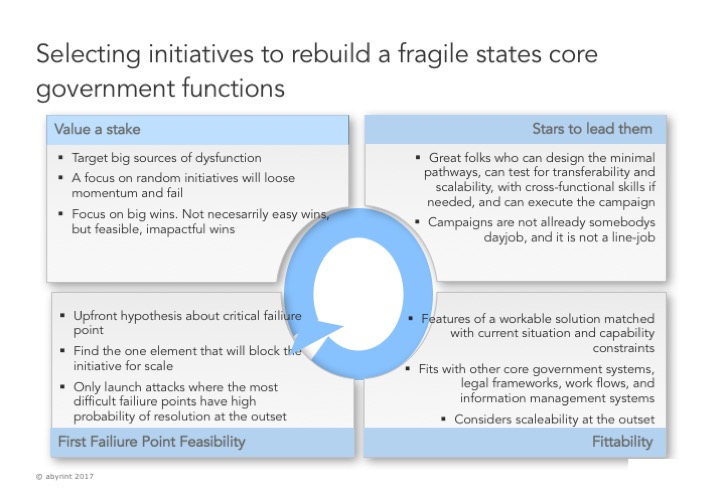Prioritization Frameworks for Reform Initiatives in Post-Crisis Reconstruction
Published on: Mon Dec 11 2017 by Ivar Strand
By what criteria can we prioritize reform initiatives when rebuilding a failed state?
A core government reform program consists of a large number of initiatives. All those opportunities do not stand equal chances of succeeding. Which opportunity to seize?
Rebuilding governments of fragile states requires agility. This is a buzzword concept, admittedly a dated one, but probably a relevant one for fragile states. Selecting the reform initiative is the critical step in being agile.
Most of the literature and guidance of agile methodologies is originally designed for IT and technology developments in highly functioning markets and organizations. There is a need for some adaptation. At Abyrint we work with fragile states to resolve very specific problems, and to develop tailored solutions.
In a series of articles we discuss key strategic principles for rebuilding state capability.
There are many issues to consider when rebuilding a state. The approach to change management is critical.
Here is our guide for choosing the initiative.
Reform minded leaders stand the best chance of succeeding by selecting an initiative that meets the following four criteria:
Exhibit 1: Criteria to select reform initiative

Criteria 1: Value at stake
This is about strategic importance of the problem. The idea is to focus on big sources of dysfunction. While obvious, this is not always easy in practice. Identifying the largest sources of dysfunction requires specific analysis and interrogation of the situation. Only then can you be sure that you address the right issue to begin with.
Many reforms and “strategic plans” in fragile states are based upon standard lists of what should be in place. They are designed on blueprints from some other country.
In environments where where everything is broken this may occasionally appear to succeed. When there is so much dysfunction, nearly any initiative to build capacity will yield some benefit.
A more targeted and relevant approach is to identify what exactly is causing the dysfunction. This needs to be prioritized the by order of magnitude in order to identify the critical initiatives.
A focus on random initiatives, drawn from a standard list of “good looking governments”, will lose momentum and fail. Generic blueprints does not reliably lead to change in behavior. While useful things may happen, it is bound to also waste resources on reforming less useful items.
Identify the big wins for this particular situation. Not necessarily the easy ones, but those that are feasible with directed effort, and that could yield substantial impact.
Criteria 2: First failure point opportunities
This is about identifying at the outset what the critical failure point is. This is beyond a standard “risk assessment”. It is about finding precisely the one element that will block the initiative for going to scale. Ideally, only launch an initiative where the most difficult failure points have a high probability for resolution at the outset.
This is very demanding on the analysis and design. Identifying the critical failure points requires robust analysis. It may also be possible to design approaches that work around such failure points, or staggers the implementation. Staggered approaches can be successful as long as they deliver value at the outset.
An example from an initiative where we helped a government in reforming security sector finances. Several failure points were identified in this large reform. A first failure point was the need for support from the security forces leadership. This eventually fell into place and allowed the initiative to start.
Another potential failure point was about the lack of investment funding for HR and technology investments. Government had little investment capability and needed something that could work at low cost.
This reform was designed to implement and and deliver the core functionality first. Most important was treasury control of security finances and that salaries were delivered on soldier’s bank accounts. Other Human Resource issues would need to be addressed later. Also, more advanced technology support will need to be addressed eventually. This needs significant investments. It will take much time. Important functions can still be delivered much before that and at much lower cost.
Criteria 3: Fittable solutions
This is about the features of the solution being fittable into a more complicated system. Most core government systems are interdependent and interface with each other. The design logic should consider this at the outset. Otherwise the initiative will not fit and cannot scale into the larger government subsystems.
Legal concepts, organizational models, work flows, and information systems all need to consider the fittability into the large government system. The idea of scalability is related to this. But this is not so much about numbers, i.e going from 100 to 10.000. This is more about ability to scale the solution into the other subsystems of a government. It is about integration.
Finding building blocks there fit for purpose is difficult. There are important issues to consider when selecting the building blocks for rebuilding state capacity.
Ensuring integration requires talented designers and a talented team to implement the reforms.
Criteria 4: Stars to lead them
Having a good team in place is critical. These are the great folks that can identify the critical problems, design the solutions, test for fittability, and execute the implementation. More often than not, having the great team is the critical constraint, and the first failure point.
Such teams, when they evolve, are rarely built for one specific purpose. They tends to be a resource for many critical initiatives. They are sought after and work across important initiatives in government. Many core government rebuilding initiatives are related. A talented team can be usefully deployed across a portfolio of initiatives.
Building such teams is demanding and need a pooled effort of external and internal resources. There must be both line workers and cross-functional expertise in the team.
At Abyrint we work with fragile states governments. We support the rebuilding of core government systems, enabling the states to manage themselves.
In a series of articles we focus on the ideas behind how we work.
Ivar Strand is founder and Managing Partner of Abyrint.



